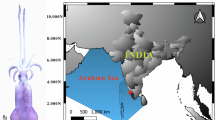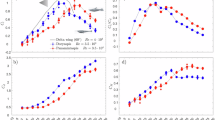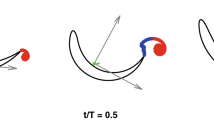Abstract
THE cephalopods and fishes are rivals as fast-moving predators and they show many parallel adaptations1. We present here evidence that in squids and cuttlefishes the statocysts possess semicircular canals, though of rather imperfect form. Animals that move quickly need to monitor angular rotation in order to allow appropriate adjustments of the eyes as they turn. To provide this facility certain critical physical requirements must be met and semicircular canals provide this. Their small size ensures that during rotation the pattern of flow is dominated by viscous damping. Consequently the actual volume of fluid flow is small, permitting “accurate transduction of the volume displacement of fluid by means of a water-tight ‘swingdoor’ cupula having limited angular excursion in the ampulla”2. Furthermore, in vertebrates, the low Reynolds number of the system (less than one) ensures that “the velocity of relative flow becomes strictly proportional to the inertial force driving it and hence to the angular acceleration of the head”. The statocysts of the fast-moving cephalopods have gone some way to meet these requirements by their shapes, and by the arrangement of the strange anticristae, projections that partly divide the cavity.
This is a preview of subscription content, access via your institution
Access options
Subscribe to this journal
Receive 51 print issues and online access
$199.00 per year
only $3.90 per issue
Buy this article
- Purchase on SpringerLink
- Instant access to full article PDF
Prices may be subject to local taxes which are calculated during checkout
Similar content being viewed by others
References
Packard, A. Biol. Rev. 47, 241–307 (1972).
Jones, G. M. The Handbook of Sensory Physiology (ed. Kornhüber, H. H. Vol. VI/I(1), 171–184 (Springer, Berlin, 1974).
Young, J. Z. Proc. R. Soc. B 152, 3–29 (1960).
Budelmann, B. U. Symp. Zool. Soc. Lond. No. 38, 309–322 (1977).
Dilly, P. N., Stephens, P. R. & Young, J. Z. J. Physiol. Lond. 249, 59P–61P (1975).
Budelmann, B. U. & Wolff, H. G. J. comp. Physiol. 85, 283–290 (1973).
Stephens, P. R. & Young, J. Z. J. Zool. Lond. 180, 565–588 (1976).
Young, J. Z. Symp. Zool. Soc. Lond. No. 38, 377–434 (1977).
Jones, G. M. & Spells, K. E. Proc. R. Soc. B 157, 403–419 (1963).
Fraser, P. J. & Sandeman, D. C. J. comp. Physiol. 96, 205–221 (1975).
Author information
Authors and Affiliations
Rights and permissions
About this article
Cite this article
STEPHENS, P., YOUNG, J. Semicircular canals in squids. Nature 271, 444–445 (1978). https://doi.org/10.1038/271444a0
Received:
Accepted:
Issue date:
DOI: https://doi.org/10.1038/271444a0
This article is cited by
-
Symmetries of a generic utricular projection: neural connectivity and the distribution of utricular information
Journal of Mathematical Biology (2016)
-
An angular acceleration receptor system of dual sensitivity in the statocyst ofOctopus vulgaris
Experientia (1985)
-
The response of theOctopus angular acceleration receptor system to sinusoidal stimulation
Journal of Comparative Physiology A (1985)
-
Chemical and structural characteristics of statoliths from the short-finned squid Illex illecebrosus
Marine Biology (1983)



